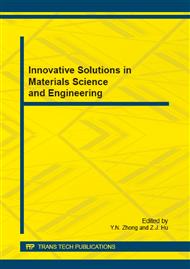[1]
Puu-An Juang, Da-Wei Gu. Finite Element Simulation for a New Disk-Type Ultrasonic Stator[J]. IEEE TRANSCTIONS ULTRASONICS, FERROELECTRICS, AND FREQUENCY CONTROL, 2003, 50(4) : 368-374.
DOI: 10.1109/tuffc.2003.1197959
Google Scholar
[2]
Tiersten, H. F. Hamilton's Principle For Linear Piezoelectric Media[J]. Proceedings of the IEEE. 1967: 1523–1524.
Google Scholar
[3]
Y. Kagawa, T. Yamabuchi, Finite Element Simulation of a Composite Piezoelectric Ultrasonic, Transducer[J]. IEEE Tran. . Sonics and Ultrasonics. 1979, 2(2): 81.
DOI: 10.1109/t-su.1979.31071
Google Scholar
[4]
Janker P, Claeyssen F. New actuators for aircraft and space applications[A]. Actuator 2008, 11th International Conference on New Actuators [C]. Bremen, Germany, 2008: 346-354.
Google Scholar
[5]
Petit L, Rizet N, Briot R, et al. Frequency behavior and speed control of piezomotors [J]. Sensors and Actuators A: Physical, 2000, 80(1): 45-52.
DOI: 10.1016/s0924-4247(99)00013-8
Google Scholar
[6]
ZHANG Xinliang, TAN Yonghong. Identification for rotary traveling wave ultrasonic motor based on input-voltage-dependent parameters[J]. Journal of System Simulation, 2008, 20(13) : 3492-3499.
Google Scholar
[7]
WAND S Y. A finite element model for the static and dynamic analysis of a piezoelectric bimorph[J]. Inational Journal of Solids and Structures, 2004, 41(15) : 4075-4096.
DOI: 10.1016/j.ijsolstr.2004.02.058
Google Scholar
[8]
ZHANG Chunliang, MIE Deqing, CHEN Zichen. Fuzzy generalized predictive control of microvibration isolation system for a micro-manufacturing platform[J]. Chinese Journal of Mechanical Engineering, 2007, 43(12) : 194-202.
DOI: 10.1109/acc.2003.1240408
Google Scholar
[9]
LI Guoyong. Simulation research of constrained implicit generalized predictive control algorithm with constrained input[J]. Junrnal of System Simulation, 2004, 16(17) : 1533-1535.
Google Scholar
[10]
WU Junfeng, WANG Shiming. Research method on a two-step general predictive control based on fuzzy control[J]. Electric Machines and Control, 2010, 14(7) : 75-80.
Google Scholar
[11]
HUANG Qinghua, WEI Shoushui, ZHAO Chunsheng. Equivalent circuit model and parameter identification of ultrasonicmotor[J]. Micromotors, 2003, 36(5) : 14-16.
Google Scholar
[12]
ZHANG Jiantao, ZHANG Tiemin. Development of servo control technique on ultrasonic motors[J]. Electric Machines and Control, 2009, 13(6) : 879-885.
Google Scholar


